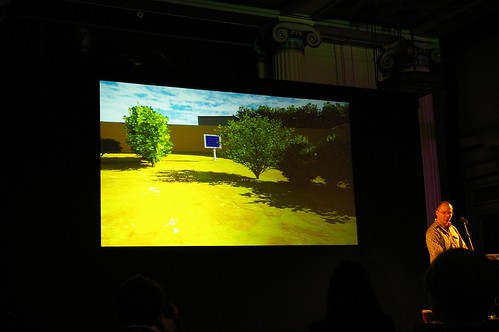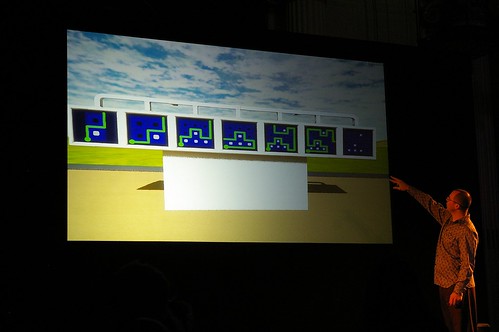This morning's Guardian breakfast posed some interesting food for thought: what are the games that marked the most significant milestones in gaming history. Clearly a contentious topic and I won't go in to the list here; I think that most people, when faced with the list, would come up with alternative games that they feel are more significant for different reasons.
It rings true though, that there are certain games which simply change something in your mind about how games work or the potential for games to work. In part of today I saw a group of graduates discussion their first commercial venture, QUBE. As the game is a first-person-puzzler (for want of a better term) it draws comparison to Portal, although there appears to be no desire to add plot or implied narrative to the puzzles.
These two things coming together reminded me what is so startling about Portal. In terms of gameplay it is an extremely clever way to frame a puzzle game. What is more remarkable is the way in which a rich narrative is told without any secondary characters (apart from the voice), cutscenes or story events. As a distinction from, say, Myst - which is an adventure game with puzzles inserted - Portal is a puzzle game with a rich, hidden narrative. It's like being presented with a wordsearch in which the shape of the lines form words across consecutive pages to read "HELP ME IAM HELD PRIS ONER".
All of which mental wanderings bring me to the second of Jonathan Blow's presentations which I attended about his new game The Witness. Loved by many for creative the 2D time-shifting platform-puzzler Braid, many were, perhaps, surprised to find that his new project is set in a 3D environment with first-person controls. Chris Hecker (Spy Party) was in the position, as friend of Jonathan, to ask the inevitable cheeky question: "So what do you say to the young developers we are always telling to avoid 3D and make 2D games?"
It rings true though, that there are certain games which simply change something in your mind about how games work or the potential for games to work. In part of today I saw a group of graduates discussion their first commercial venture, QUBE. As the game is a first-person-puzzler (for want of a better term) it draws comparison to Portal, although there appears to be no desire to add plot or implied narrative to the puzzles.
These two things coming together reminded me what is so startling about Portal. In terms of gameplay it is an extremely clever way to frame a puzzle game. What is more remarkable is the way in which a rich narrative is told without any secondary characters (apart from the voice), cutscenes or story events. As a distinction from, say, Myst - which is an adventure game with puzzles inserted - Portal is a puzzle game with a rich, hidden narrative. It's like being presented with a wordsearch in which the shape of the lines form words across consecutive pages to read "HELP ME IAM HELD PRIS ONER".
All of which mental wanderings bring me to the second of Jonathan Blow's presentations which I attended about his new game The Witness. Loved by many for creative the 2D time-shifting platform-puzzler Braid, many were, perhaps, surprised to find that his new project is set in a 3D environment with first-person controls. Chris Hecker (Spy Party) was in the position, as friend of Jonathan, to ask the inevitable cheeky question: "So what do you say to the young developers we are always telling to avoid 3D and make 2D games?"
Jonathan laughs, caught out. "We always say," he tells the audience, "the worst mistake is to make a 2D indie game ... make a decent amount of money to fund future development and then try something ambitious and obscure in 3D that no-one wants to play and lose all your money ... I'd never recommend to anyone to do what I'm doing."
But the reason for this departure is a deep love of adventure games, or a least a deep love of what adventure games should be. Speaking on the death of adventure games, Jonathan says "other games evolved to be more playable - adventure games never figured out how to do that." Frustrated by a genre which mostly revolved around hoarding inventory items, randomly combining objects and failing to interact with scenery, Jonathan has set out to make a true adventure game which combines the joy of exploration with environment based puzzles which play by a fair set of rules.
He demonstrates a good set of the opening of the game and it is clear that the player is taught how to understand the puzzles in the game a little at a time, without any text displays or audio prompts. Simple line puzzles build into basic mazes and then evolve into complex mazes with pathing rules. Basic levers are identified early as well as active and inactive switches and through an elegant opening puzzles players are taught how power lines from nearby puzzle stations to environmental objects allow passage.
The game itself was subjective to a blind playtest at Pax, without the gamers being told it was by the Braid creator. "I don't really like feedback," he causes the audience to laugh, "[the pax playtest] was more of a reality check."
There is an obvious disconnect between the puzzles and the setting. Jonathan insists that this is in keeping with the fiction of the story as well as providing a fair interface for players. "In a game like Myst each machine is disguised to go with the scenery so the player spends ages just trying to figure out how the buttons move or if its a screen or whatever."
But the reason for this departure is a deep love of adventure games, or a least a deep love of what adventure games should be. Speaking on the death of adventure games, Jonathan says "other games evolved to be more playable - adventure games never figured out how to do that." Frustrated by a genre which mostly revolved around hoarding inventory items, randomly combining objects and failing to interact with scenery, Jonathan has set out to make a true adventure game which combines the joy of exploration with environment based puzzles which play by a fair set of rules.
He demonstrates a good set of the opening of the game and it is clear that the player is taught how to understand the puzzles in the game a little at a time, without any text displays or audio prompts. Simple line puzzles build into basic mazes and then evolve into complex mazes with pathing rules. Basic levers are identified early as well as active and inactive switches and through an elegant opening puzzles players are taught how power lines from nearby puzzle stations to environmental objects allow passage.
The game itself was subjective to a blind playtest at Pax, without the gamers being told it was by the Braid creator. "I don't really like feedback," he causes the audience to laugh, "[the pax playtest] was more of a reality check."
There is an obvious disconnect between the puzzles and the setting. Jonathan insists that this is in keeping with the fiction of the story as well as providing a fair interface for players. "In a game like Myst each machine is disguised to go with the scenery so the player spends ages just trying to figure out how the buttons move or if its a screen or whatever."
Following this I had the honour of being invited to a presentation by some students and ex-students from Newport Uni's games design course. Having now witnessed Jonathan Blow describe twice the process of educating a player about the rules of a game it's encouraging to see that these less-experienced graduates have taken on board the same skills. The beta level for Qube (available here at the time of writing) demonstrates this same, structured, non-narrative tutorial guiding the player through the individual rules and behaviours before attempting to combine them and looks very polished indeed at this stage.
There were a range of games displayed by the students. Hannah and Harry's ColourRunners (which I talked about on Wednesday) were there again and another group of students who are turning their final year project into a commercial product. It's encouraging to hear how much support Microsoft have provided to these under-graduates, providing access to hardware and dev kits for the at-the-time unreleased Windows 7 Mobiles.
There were a range of games displayed by the students. Hannah and Harry's ColourRunners (which I talked about on Wednesday) were there again and another group of students who are turning their final year project into a commercial product. It's encouraging to hear how much support Microsoft have provided to these under-graduates, providing access to hardware and dev kits for the at-the-time unreleased Windows 7 Mobiles.
Speaking of new Microsoft hardware...


No comments:
Post a Comment